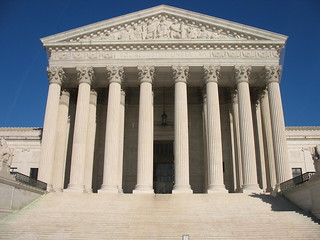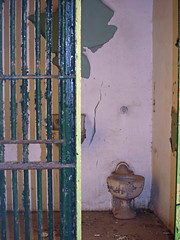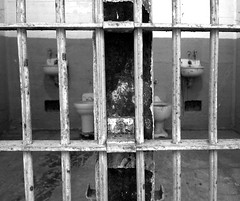Archive for Criminal Justice
Infographic: Invest in People, Not Prisons
Rethinking Juvenile Justice: The Supreme Court Decision
 Last week United States Supreme Court declared it cruel and unusual punishment to sentence a juvenile offender to life without parole. As with all of their decisions, it was met by some with complete outrage and by some as a move long-needed.
Last week United States Supreme Court declared it cruel and unusual punishment to sentence a juvenile offender to life without parole. As with all of their decisions, it was met by some with complete outrage and by some as a move long-needed.
This one is based on a growing body of research, one that has influenced court decisions since around 2005. Neurophysical examination of children and youths has shown that there are very direct and physical reasons that the prior approach to juvenile justice does not work.
Ethan Bronner of The New York Times provides a bit of historical background on these prior court cases:
“What we are seeing is a very stark and important rethinking of how we treat juvenile criminal offenders,” said Marsha Levick, who co-founded the nonprofit Juvenile Law Center in Philadelphia in 1975. “For years we were trying to convince the courts that kids have constitutional rights just like adults. Now we realize that to ensure that kids are protected, we have to recognize that they are actually different from adults.”
That sense of difference has fueled the Supreme Court decisions of the past seven years — first a ruling that barred the death penalty for juveniles in 2005; one that banned life in prison for juveniles convicted of crimes other than homicide in 2010; and now Monday’s ruling that rendered invalid state laws requiring youths convicted of homicide as well to die in prison. That decision will lead to resentencing hearings for about 2,000 convicts — some of them now well into middle age — in more than two dozen states.
All of the recent rulings placed emphasis on research showing that the less-formed brains of the young make them less morally culpable and more capable of change later. So condemning them to die in prison, advocates assert, ignores key advances in scientific understanding.
In addition to the evidence provided by the physical sciences there is also the problem of cookie-cutter justice, a “one size fits all” approach that removes judicial discretion from the picture.
Conservative writer Elizabeth Hovd on Oregon Live casts things in terms of the rights that we as a nation choose to bestow and which to deny. It’s a very interesting exercise when you consider the ages involved.
Justice is better served by weighing individual considerations than by following mandatory sentencing laws that offer no opportunity to rehabilitate people or allow them to become contributing members of society some day. If we are comfortable claiming people aren’t old enough to fully consider who to vote for before age 18 or be responsible with a beer until 21, banning mandatory life-without-parole sentencing for juveniles makes sense. Parole can and should still be denied if a criminal seems unchanged or is considered a continued threat to society.
Hovd also invokes Christian charity along with a reminder that if you do actually read the decision you’ll discover that this is not an automatic out for everyone, merely the rectification of a poor approach – one that dispenses with actual justice far too often.
It is far more important that we do what is right by victims and offenders than that we copy other countries. I would remind fellow conservatives who are also Christians that ours is a god of second chances — a god of the mulligan. Isn’t it our job to show mercy to penitent men, just as God has shown mercy? Besides, punishment and revenge have never brought back a loved one.
This ruling doesn’t offer a get-out-of-jail-free card. It does stop the legal system from treating children like adults. Children aren’t typically ready to drive at 12 or vote at 14. And children don’t magically turn into adults when they commit a horrible act.
That last point is the one that most people miss: these are children. This is one of the reasons that we produced Born, Not Raised. People need to be exposed to the narratives of the kids lost in our system. It is these narratives that humanize them.
A problem becomes much harder to ignore once you put a human face on it.
LIttle Girls in Solitary
 Solitary confinement. A harsh penalty, and purportedly one of last resort. The type of penalty reserved for hardened, adult criminals. Or so it seems on the surface…
Solitary confinement. A harsh penalty, and purportedly one of last resort. The type of penalty reserved for hardened, adult criminals. Or so it seems on the surface…
How would you react if told that solitary is often used for the most minor infractions, and the recipients are all too often female juvenile offenders. This is the subject of a recent piece on RH Reality Check by Yasmin Vafa of the Human Rights Project for Girls:
There is a growing body of evidence that demonstrates the severe psychiatric consequences of placing individuals, and particularly children in solitary confinement. Prisoners who have experienced solitary confinement have been shown to engage in self-mutilation at much higher rates than the average population. These prisoners are also known to attempt or commit suicide more often than those who were not held in isolation. In fact, studies show that juveniles are 19 times more likely to kill themselves in isolation than in general population and that juveniles in general, have the highest suicide rates of all inmates in jails.
Every year approximately 600,000 girls are arrested in the U.S. The majority of these girls are incarcerated for non-violent offenses such as truancy, loitering, running away, alcohol use, or violations of prior court orders for non-violent offenses. Evidence demonstrates that 73 percent of these girls are victims of some form of physical or sexual abuse. Many of them end up in these exact circumstances.
Despite all these facts, when girls in the juvenile justice system express evidence of or the desire to self harm, the typical response is to put them in solitary confinement. While these girls are being placed in solitary for their own protection, there is no consideration given to the fact that such practices deepen existing trauma. When subjected to isolation, these youth are often locked down for 23 hours per day in small cells with no natural light. This confinement can last several days, weeks or even months, which leads to severe anxiety, paranoia, and further exacerbation of mental distress. The ACLU has reported that in certain juvenile detention facilities, girls are restrained with brutal force and are ‘regularly locked up in solitary confinement — a punishment used for minor misbehaviors as well as for girls who express wanting to hurt themselves.’
This is an especially important topic because this week, the Senate Judiciary Subcommittee on the Constitution, Human Rights, and Civil Rights is holding their first-ever Congressional hearing on the issue of solitary confinement in U.S. prisons and jails. It is our distinct hope that we will see the subject of juvenile solitary confinement addressed in this hearing, as well as the other other issues faced by both juveniles and females incarcerated in the American prison system.
Catholic Conference States Support of Alternatives to Incarceration
The New York State Catholic Conference has just made a formal online statement coming out in support of rehabilitation programs over mere incarceration.
Their announcement references the two things we feel to be most significant about this approach – lowering the cost to the public and achieving greater results when reintegrating the convicted back into society.
Here are the summary and statement of position from their announcement:
Summary
Many of those incarcerated in New York State prisons are afflicted with mental health or addiction problems. These individuals, and the greater society, would be best served by offering lower-cost alternatives to incarceration to address the problems that are at the root of their criminal activity.
Conference Position
The Catholic Conference supports efforts to reduce crime and recidivism, and to help former offenders recover and live productively in the community through expansion and improved coordination of alternatives to incarceration for mentally ill and addicted offenders throughout New York State.
While religion is not something we discuss, it is heartening to see religious organizations becoming aware of the data on which we’ve based our own findings. It’s all part of a positive trend we are seeing in many states towards programs that are both effective and cost-effective, either of which is a step forward.
Unfortunately, these approaches are frequently passed over in favor of short-term savings. Despite the fact that we are all feeling the financial crunch, we must spend slightly more now to save much larger amounts of money over the next few years.
As politicians on both sides of the aisle are hunting for places to slash spending, many of these programs are being endangered. For example, here in my native New Orleans, we are waiting for word on whether the five programs that really do some good are about to shut down due to funding cuts.
The more organizations get on the same page, the better hope we have of fixing our broken system.
A discussion of the new PREA (Prison Rape Elimination Act) Standards
You are invited to join the conversation with Dana Shoenberg and Jason Szanyi from the Center for Children’s Law and Policy, and Jessica Sandoval from the Campaign for Youth Justice,
On Tuesday June 19th at 2:00 PM EST
Please RSVP to info@njjn.org for call-in information.
On May 17, 2012, The Department of Justice released its final rule for the implementation of the Prison Rape Elimination Act (PREA). The rule sets national standards for prevention, detection and response to sexual misconduct in four categories of facilities: juvenile facilities, adult prisons and jails, lockups, and community confinement facilities. The teleconference will address the following questions:
- What kinds of facilities are/are not covered?
- What are some key provisions that will protect youth in custody?
- What are the implications for individual states?
- How will state implementation be audited?
- How can you help establish systems of support for those who have been victimized?
- What are the implications for youth who are in the adult system?
- How you can weigh in on appropriate staffing ratios for youth facilities.
Participants in the teleconference will discuss an outstanding issue for which the Justice Department is seeking additional public comment: by early August, it will be important for advocacy groups to weigh in about the rule’s required staffing ratios in juvenile facilities. We encourage participants to find out what the required or current operating staffing levels are in your state and local facilities, as we would like to have some discussion about positions advocates can take on this issue.
The information above was supplied by the National Juvenile Justice Network, a national organization of state-based youth justice coalitions and organizations that work to promote the reform of America’s critically flawed youth justice system at every level.
Equal Justice Initiative Founder: ‘We Need to Talk About an Injustice’ TED Talk
TED2012 helped Bryan Stevenson raise more than $1 million following his impassioned plea for justice at the California conference last week. Stevenson, a human rights attorney and founder of the Equal Justice Initiative, spoke about the role of race in today’s justice system, including juvenile justice. You can watch his talk below.
Dana Kaplan – A Call to Action: Criminal Justice Reform
Where is the world’s prison capital? Would you believe Louisiana?
 Unfortunately I find it all too easy to believe. As long time readers are aware, I’m the member of the team who is not in San Diego. I’m located in my home town of New Orleans, a city as rich in culture as it is in tragedy.
Unfortunately I find it all too easy to believe. As long time readers are aware, I’m the member of the team who is not in San Diego. I’m located in my home town of New Orleans, a city as rich in culture as it is in tragedy.
Cindy Chang of the New Orleans Times-Picayune showed us just how bad things have become in her cover story yesterday.
Louisiana is the world’s prison capital. The state imprisons more of its people, per head, than any of its U.S. counterparts. First among Americans means first in the world. Louisiana’s incarceration rate is nearly triple Iran’s, seven times China’s and 10 times Germany’s.
The hidden engine behind the state’s well-oiled prison machine is cold, hard cash. A majority of Louisiana inmates are housed in for-profit facilities, which must be supplied with a constant influx of human beings or a $182 million industry will go bankrupt.
I’ve often written about creeping privatization in our justice system, and with good reason. How can actual justice be involved when the bottom line is to fill as many beds as possible? It’s basic common sense that the two are incompatible, and the latter is ethically questionable.
Even worse is the fact that this approach is funneling money away from programs that do work. Chang continues:
More money spent on locking up an ever-growing number of prisoners means less money for the very institutions that could help young people stay out of trouble, giving rise to a vicious cycle. Louisiana spends about $663 million a year to feed, house, secure and provide medical care to 40,000 inmates. Nearly a third of that money — $182 million — goes to for-profit prisons, whether run by sheriffs or private companies.
‘Clearly, the more that Louisiana invests in large-scale incarceration, the less money is available for everything from preschools to community policing that could help to reduce the prison population,’ said Marc Mauer, executive director of The Sentencing Project, a national criminal justice reform group. ‘You almost institutionalize the high rate of incarceration, and it’s even harder to get out of that situation.’
It pains me to see my hope at the forefront of such a misguided and disastrous trend, especially in these recent years after Hurricane Katrina and the levee failure. We now lock up more human beings than any place else in the world, and yet we still have one of the highest rates of violent and property crime in the entire United States. It’s just not working.
If you want a look at what the rest of the nation will look like if we do not reverse this trend of privatization, read Ms. Chang’s article. It is an extensive and disturbing piece of reporting that will send chills down your spine. I’d also recommend Charles Mondonado’s article in Gambit Weekly – Privatizing Louisiana’s Prisons.
There is a truly frightening future being forged, and I am sitting on it’s leading edge. Please take a look at what is happening down here. Educate yourself before this model becomes the norm.
It is far more expensive to do nothing.
Federal Intervention Requested at Orleans Parish Prison
 Tuesday evening the Southern Poverty Law Center filed for a preliminary injunction against the New Orleans sheriff’s office. This filing pointedly requested the intervention of a federal judge due to the severity of the allegations.
Tuesday evening the Southern Poverty Law Center filed for a preliminary injunction against the New Orleans sheriff’s office. This filing pointedly requested the intervention of a federal judge due to the severity of the allegations.
This action come a mere one month after the SPLC filed a proposed class-action lawsuit against Orleans Parish Sheriff Marlin Gusman over unsafe and unconstitutional jail conditions. Allegations that were supported by a Department of Justice inspection a few weeks later that found “inadequate staffing levels in jail facilities, pervasive violence and substandard mental health care.”
These findings were hardly shocking to anyone who was paying attention back in 2009 when prior DOJ investigations revealed a similar level of unconstitutional activities. In the intervening time, to the intense frustration of advocates, there was practically no public communication from the feds or local authorities about how to resolve the problems.
This latest filing by the SPLC requests U.S. District Judge Lance Africk to both grant investigating attorneys “expedited discovery” and hold a hearing about the conditions in jail within the next 90 days. (It is worth noting that Gusman’s office had asked last month for an extension of the original lawsuit.)
As if the findings prompting the lawsuit were not enough, reports are now filtering in about escalating violence in the facilities under scrutiny – violence that seems to have a level of retribution in its make-up.
Laura Maggi, a reporter for The Times-Picayune, brings us the unpleasant details:
Since the lawsuit, there has been an ‘uptick’ in violence, while inmates who need mental health care continue to be neglected, wrote Katie Schwartzmann, managing attorney for the law center. For example, the filing accuses jail deputies of anally raping an inmate with an object, beating up another shackled inmate and failing to protect three inmates attacked by other inmates.
One of the original plaintiffs, inmate Kent Anderson, signed an affidavit that deputies have threatened him since the lawsuit, saying they could move him back to a jail facility where he believes isn’t safe. ‘Since my lawyers filed the lawsuit, things have been hell for me. Deputies tell me, ‘You want to complain about things? You want to tell your lawyers? We’ll send you back to Old Parish Prison,” according to the affidavit.
Our justice system is flat out broken, there is no other way to truthfully describe it. Conditions of overcrowding and violence are found across the nation, and often in facilities housing not only male offenders, but also those incarcerating women and youths.The situation in Orleans Parish Prison is a horrible reminder of this fact.












